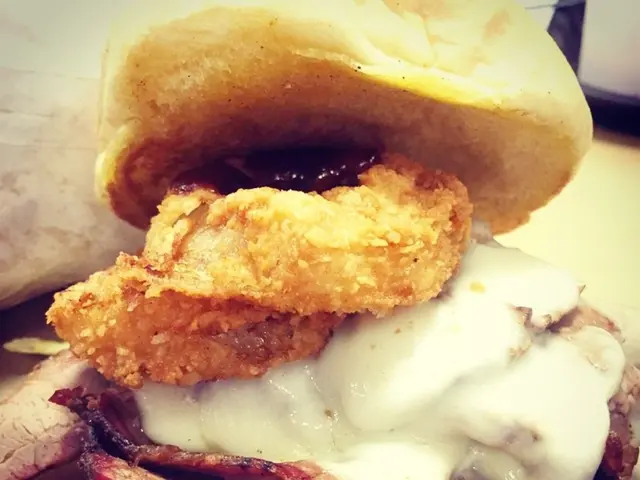Fast Food: Is Healthy an Option?
Discover Fast Food Choices for a Balanced Diet
Fast food may not be the synonym for healthy eating, but it ain't entirely off-limits either. Fast food often packs calories, sodium, and unhealthy fats, typically enough for a day in one sitting. It's low in essential nutrients like vitamins, minerals, fruit, veggies, and fiber.
But fear not, you don't have to ditch those fast-food cravings entirely! When hunger strikes and time is of the essence, fast food can be a convenient, tasty, and budget-friendly choice. Just remember to practice moderation when it comes to fast-food joints and pick your orders wisely.
Navigating fast-food menus can be tricky when watching your weight or health. Finding a well-balanced meal in most fast-food restaurants might seem challenging. However, there are always smarter choices to make. Follow our tips and menu recommendations to help you stay on track and make healthier fast-food choices:
- Budget Your Calories: Aim to keep your entire meal no more than a third of your recommended daily caloric intake. Most of us consume 836 calories per fast-food meal—beware of underestimating the calories you eat! Take advantage of nutritional information available on chain websites or at the restaurant location.
- Protein and Fiber Rule: Opt for foods that are lower in fat and higher in protein and fiber. Go for fiber-rich, whole-grain options, high-quality protein sources, and stay away from saturated fats. Steer clear of all items containing trans fats.
- Bring Your Own Boost: Even when you order wisely, it can be tough to get enough fiber and important vitamins and minerals from a fast-food restaurant. Pre-plan and bring healthy sides and toppings like nuts, seeds, dried fruit, carrot sticks, apple or pear slices, cottage cheese, or yogurt.
Sodium Warning
High sodium intake over time can contribute to cardiovascular disease. The American Heart Association recommends <1500mg of sodium per day and no more than 2,300mg per day. However, it can be difficult to avoid excessive sodium when eating fast food, even with lower calorie meals. Plan ahead for low-sodium meals before and after your fast-food indulgence. Ask if your meal can be cooked without added salt.
Guiding Your Choices
Many fast-food chains provide nutritional information on their websites, menus, or at the restaurant. Although these lists can be confusing, they are the best source of up-to-date information on your menu options. There are also various websites and nutrition apps that offer nutritional information in user-friendly formats.
Fast Food On the Go
Making healthier fast-food choices is easier when you plan ahead. Familiarize yourself with the nutritional guides and have a general idea of what you'll order. But if you find yourself unprepared, follow these guidelines to make wiser choices:
Smarter Fast Food Choices
- Portion Control: Many fast-food meals are supersized or value-sized, delivering several meals' worth of food in one sitting. Avoid supersized options and choose the smallest available size for sandwiches, burgers, and sides.
- Lean & Grilled Proteins: Favor grilled or roasted lean proteins over fried and breaded items like crispy chicken sandwiches or breaded fish filets.
- Menu Descriptions: Dishes labeled deep-fried, pan-fried, basted, batter-dipped, breaded, crispy, scalloped, or au gratin are usually higher in calories, unhealthy fats, and sodium. Be cautious of items in Alfredo or creamy sauces as well.
- Special Order: Many menu items can be made healthier with a few tweaks and substitutions. For example, you can ask to hold the sauce or dressing, serve it on the side, request a whole-grain bun, or opt for a lettuce wrap.
Don't Expect Miracles
- Healthy-Sounding Dishes: Be mindful that healthy-sounding dishes may not always be the best choice, such as salad dressings and fried toppings that often make salads higher in calories and saturated fat than burger alternatives.
Calorie Control Tips
- ** Condiments & Dressings:** Be aware of calorie- and fat-packed salad dressings, spreads, sauces, and sides like cheese and sour cream.
- Low- or Zero-Calorie Beverages: Avoid unnecessary calorie sources like soda, shakes, or fruit drinks that can quickly add up to a significant portion of your daily calorie intake. Opt for water, diet soda, 100% fruit juice, or unsweetened tea instead.
- Wise About Sides: Watch out for high-calorie side dishes like fries, chips, rice, noodles, onion rings, coleslaw, macaroni and cheese, biscuits, mashed potatoes with gravy, and corn on the cob. Healthier options include side salads with light dressing, baked potato, fresh fruit cups, or apple slices.
- Alternatives to Fries: Choose more nutrient-dense sides that can help you avoid that post-meal sluggish feeling typical of fast food. If fries are a must-have, opt for the smallest size.
- Skip the Bacon: While bacon adds flavor, it's high in saturated fat and calories. Choose extra pickles, onions, lettuce, tomatoes, or mustard for added flavor without extra fat.
Filling Your Fast Food Salad
- Dressings: Go for low-fat or fat-free dressings and ask for it on the side, enabling you to control how much you use.
- Skip High-Fat Toppings: High-fat toppings like bacon bits, cheese, croutons, and crispy noodles can add hundreds of calories!
- Avoid Taco Salads: Taco salads can be high-fat, high-calorie choices due to deep-fried shells, tortilla chips, cheese, and sour cream toppings.
- Opt for Grilled Chicken, Shrimp, or Vegetables: Choose salads with grilled chicken, shrimp, or vegetables rather than those with breaded chicken or other fried toppings.
Healthy Fast Food Options at Burger Restaurants
The average burger, fries, and drink combo at fast-food chains can add up to a whole day's worth of calories. Frequent eating like this over time can have negative impacts on your overall health and weight management. One burger alone at many fast-food joints can contain between 1,000 and 2,000 calories, especially with extra patties, bacon, and cheese.
To keep calories and fat to more appropriate levels, pay particular attention to portion sizes and high-fat toppings and sides. Portion control matters as every item on your plate contributes to the calorie count of your meal.
Tips for Healthier Fast Food Options at Burger Restaurants:
- Stick with a single hamburger patty rather than a double or triple burgers.
- Go light on the mayonnaise. Ask for reduced mayo or eliminate it completely and add extra ketchup or mustard.
- Limit or avoid high-fat toppings, such as cheese, special sauces, bacon, and onion rings.
- Consider a plant-based burger or sandwich options, such as the veggie burger at Burger King or the grilled cheese at In-N-Out Burger.
- Skip the fries or go small. Choose a side that is more nutrient-dense like side salads with light dressing or baked potato.
- Check out the kid's menu. Junior and children’s-sized hamburgers usually have between 250 to 300 calories, making them a better choice for keeping your portion size down.
- When choosing fast food options for healthier diets, opt for lower calorie meals that are high in protein, fiber, and whole grains. When deciding on a fast-food restaurant, look for places that emphasize nutrition and healthy-diets.
- In addition, while enjoying fast food, consider including health-and-wellness elements such as fresh fruits, vegetables, or nuts. Making mindful choices that balance fast-food indulgence with nutrient-dense options can help promote a balanced diet and overall wellbeing.








